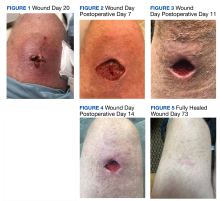Spider Bite Wound Care and Review of Traditional and Advanced Treatment Options
Background: Approaches to chronic wound care are worlds apart: In developing nations, the care of chronic wounds often involves traditional management with local products (eg, honey, boiled potato peels, aloe vera gel, banana leaves); whereas in developed nations, more expensive and technologically advanced products are available (eg, wound vacuum, saline wound chamber, hyperbaric oxygen therapy, antibacterial foam). The cost for wound care plays a significant role in total health care costs, and that cost is expected to rise dramatically.
Case Presentation: A healthy, 60-year-old man presented after being bitten by a spider 6 days earlier. He was treated and prescribed clindamycin 300 mg 4 times daily for 14 days. Despite treatment, the wound continued to enlarge, and the patient showed symptoms of septicemia. The patient was admitted to the hospital and remained for 3 days. On discharge the patient was given a prescription for doxycycline 100 mg twice a day for 10 days and instructed to use iodoform gauze to pack the wound during daily dressing changes. However, the gauze was ineffective. The patient’s dressing was switched to an antibacterial foam dressing impregnated with gentian violet and methylene blue.
Conclusions: There is a disparity in available wound care product availability. Modern products may yield faster healing times with fewer adverse effects than traditional products. Products used by local healers can produce satisfactory results when more modern products are unavailable and at a fraction of the cost.
CASE Presentation
An athletic, healthy 60-year-old Utah National Guard member presented to the George E. Wahlen Department of Veterans Affairs Medical Center in Salt Lake City, Utah, 6 days after experiencing a spider bite. For the first 6 days, the patient applied bacitracin at home. On day 7, the patient noticed that the wound was enlarging and appeared to be fluctuant. The patient was prescribed clindamycin 300 mg 4 times daily on an outpatient basis, which was taken on days 7 to 14.
The wound’s total surface area continued to expand, and the patient returned to the Salt Lake City Veterans Hospital wound care clinic on day 17 stating that the wound was very painful and more fluctuant. The wound care nursing staff were consulted, the wound was debrided, and attempts to drain the wound resulted in minimal exudate expressed from the wound. Clindamycin was increased to 450 mg 4 times daily. However, the wound continued to enlarge and become more painful.
Discussion
Traditional Wound Care
Honey. Honey has been used as a treatment for wounds for almost 3000 years. It has antiseptic and antibacterial properties and contributes to a moist wound care environment. In 2011, Gupta and colleagues reported on the use of honey in 108 patients with burns of < 50% of the total body surface area.7 This report stated that delay in seeking medical care increased wound infection rates, contamination, time to sterilization, and healing. Compared with silver sulfadiazine cream, honey dressings improved the time to wound healing (33 days vs 18 days, respectively), decreased the time to wound sterilization (1 day vs no sterilization), and had better outcomes (37% vs 81%, respectively) with fewer hypertrophic scars and postburn contractures.7







